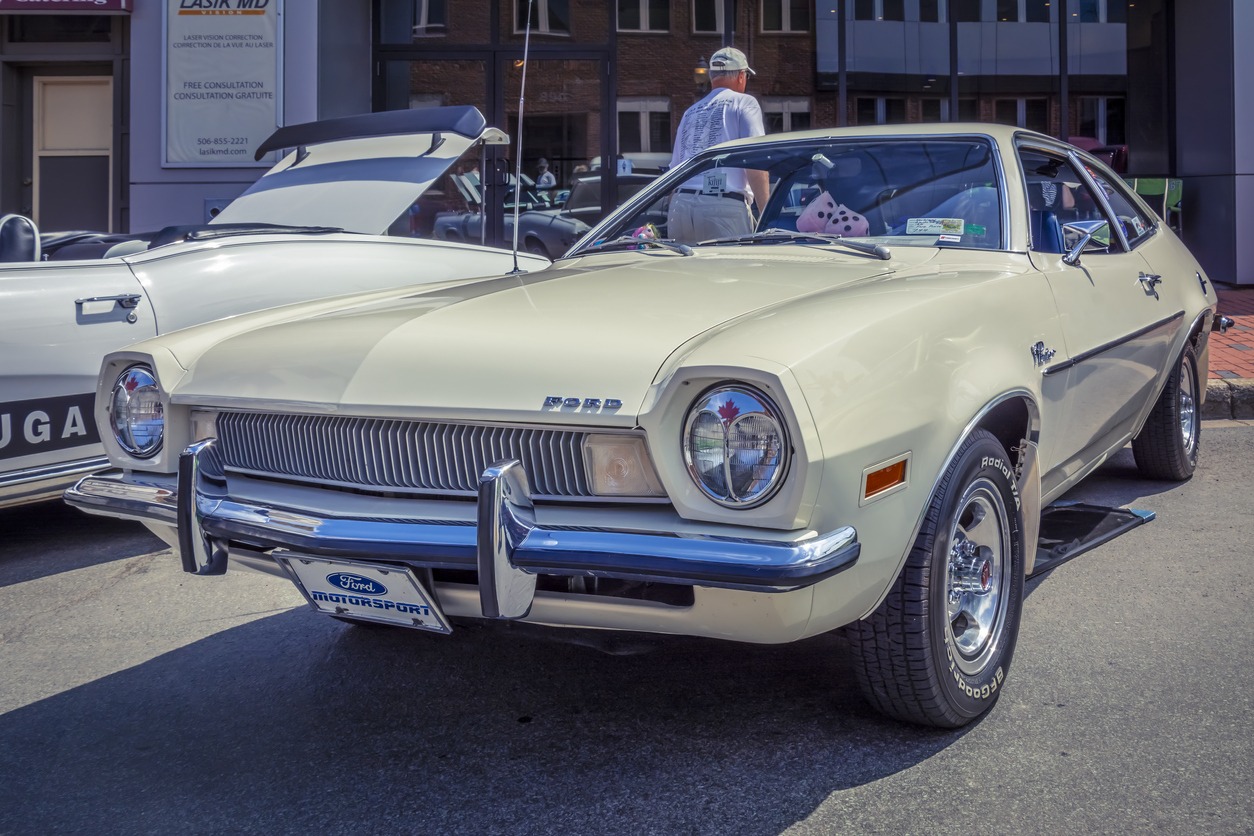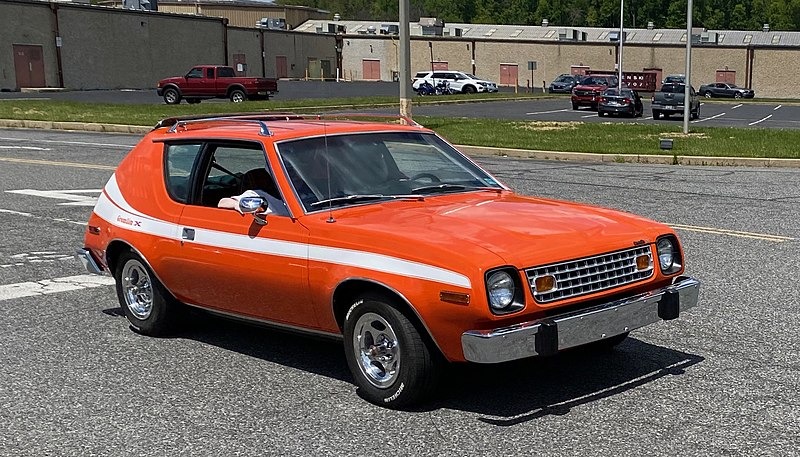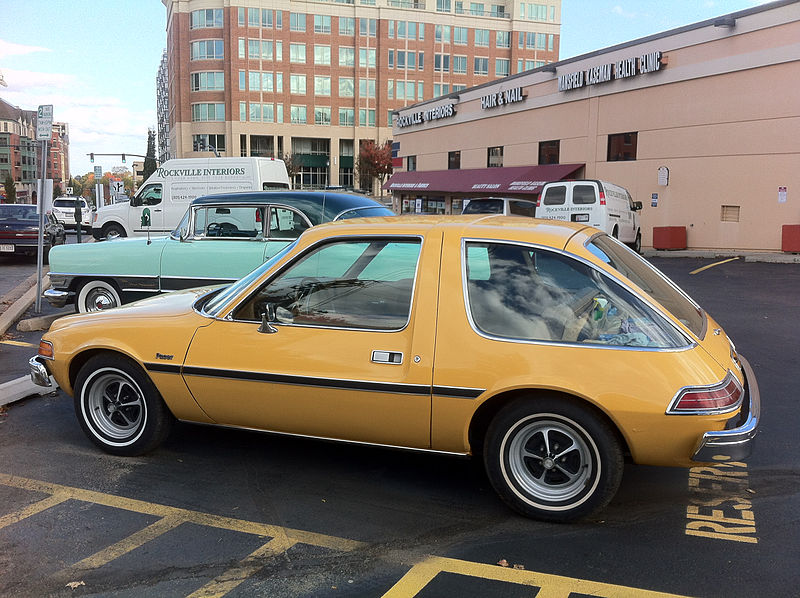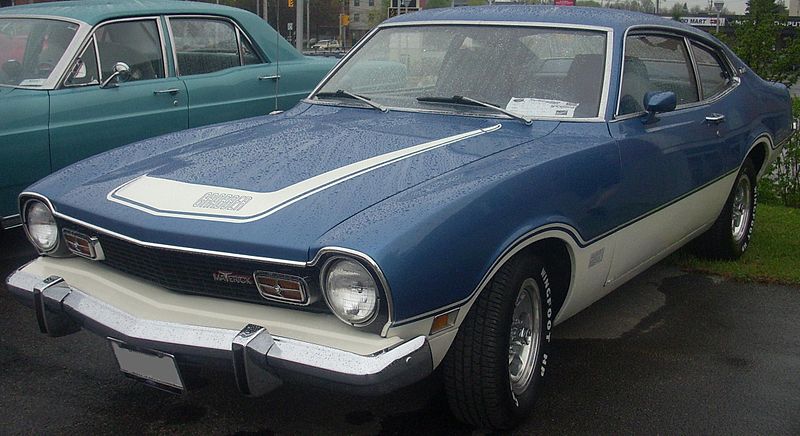The 1970s was a difficult for the automotive industry. Two major oil crises, in 1973 and 1979, defined this era, which dramatically increased fuel prices and led to gasoline shortages. This situation forced car manufacturers to hastily redesign their vehicles to be more fuel-efficient, often at the expense of quality and performance.
Additionally, the U.S. government introduced new regulations for emissions and safety during this period. The Clean Air Act and the establishment of the Environmental Protection Agency (EPA) in 1970 set strict new standards for vehicle emissions. The National Highway Traffic Safety Administration (NHTSA), established in 1970, also implemented various safety standards. Automakers scrambled to comply with these regulations, resulting in hurried and sometimes ill-conceived vehicle modifications.
Here are some of the worst cars made in the decade:
AMC Gremlin (1970-1978)
The American Motors Corporation (AMC) introduced the Gremlin in 1970, hoping to compete in the growing subcompact market. Its truncated rear end and unusual proportions made it stand out, but not necessarily in a good way. Because of its peculiar design, the Gremlin quickly gained notoriety. Technically, it was criticized for seeming outdated even at the time of its release. Performance-wise, the Gremlin was hampered by its heavy, fuel-inefficient engines and lackluster handling.
Critics also documented their displeasing comments regarding the car. Time magazine included the Gremlin in its list of the 50 worst cars, highlighting its disproportionate design and inadequate performance. CNN included the Gremlin in its list of “The Ten Most Questionable Cars of All Time,” describing it as a bold yet possibly desperate move in a market dominated by bigger players.
Despite these criticisms, the Gremlin was not a complete mechanical failure and has garnered a somewhat cult following among car collectors. It stands as a symbol of the ’70s, with a love-or-hate reputation akin to other quirky trends of the era. The Gremlin’s unconventional design and launch on April Fool’s Day in 1970 reflect its unique place in automotive history.
Ford Pinto (1970-1977)
The Ford Pinto, a car that became notorious for all the wrong reasons, was launched in 1970 but had a short run, being discontinued by 1977. The Pinto is remembered mostly for its serious safety flaws, leading to a massive recall and a public relations nightmare for Ford.
The car gained infamy for exploding when hit from behind. Shockingly, it was revealed that Ford knew about this defect but calculated that paying off victims would be cheaper than making the car safer. Also, the doors could jam in accidents, increasing the danger for its occupants. This kind of negative publicity certainly didn’t help its sales.
Beyond the safety issues, the Pinto also suffered from poor build quality and unimpressive performance. Despite being a decent seller initially, Pinto’s reputation took a nosedive with the discovery of its hazardous fuel tank and the damning “Pinto memo,” revealing Ford’s neglect. The car’s legacy is further tarnished by its inclusion in lists like Time magazine’s 50 worst cars and various others highlighting its questionable safety and design choices.
The Pinto’s name also added to its troubles. Chosen to evoke the image of a horse, like the Mustang, it unfortunately translates as “male genitalia” in Portuguese, hindering its market appeal in Brazil. This naming misstep landed the Pinto in discussions about the worst name oversights in car history.
Chevrolet Vega (1971-1977)
The Chevrolet Vega initially seemed like a winner when it hit the market in 1971. Offered by General Motors in various body styles with a flat-four engine, it even snagged the title of Motor Trend’s 1971 Car Of The Year. In its first year, the Chevy Vega was a popular choice among American consumers, boasting decent sales.
However, the Vega’s success was short-lived. Soon after its debut, it became clear that the Vega wasn’t living up to expectations. It was riddled with mechanical and reliability issues and had a notorious tendency to rust. Its aluminum engine was prone to overheating and warping, leading to oil leaks and engine failures.
By the late 1970s, the Vega was scrapped at such a high rate that many junkyards refused to take them. By 1977, the Vega was discontinued.
AMC Pacer (1975-1980)
The AMC Pacer was another attempt by American Motors to innovate in the small car market. With its wide body and extensive use of glass, the Pacer was certainly unique in appearance.
However, its odd styling was not well-received, and its large glass area made the interior uncomfortably hot in sunny conditions. The Pacer was also underpowered and not particularly fuel-efficient, failing to meet the demands of the era.
Despite its rocky start and quick disappearance from the streets, the Pacer’s reputation has seen a positive shift over time. Nowadays, this unique car is a collector’s item, though it’s still not the go-to for fuel efficiency.
Bricklin SV-1 (1974-1975)
The Bricklin SV-1, a creation of automotive entrepreneur Malcolm Bricklin, is a lesser-known sports car from the 1970s. This Canadian sports car was intended to be both stylish and safe. Its most notable feature was its gull-wing doors.
Despite its striking design, the SV-1 didn’t make much of an impact in the automotive world. It had a lot in common with the DeLorean in terms of its troubled history and limited success. It suffered from many issues: the doors were prone to malfunction, the build quality was poor, and the car was overweight, negatively impacting both performance and fuel economy.
Plagued by quality issues and a rising price tag, the SV-1’s production came to a halt just a year after its debut, with only 3,000 units ever made. The Bricklin SV-1’s journey was short-lived, ending in 1976 when the company faced receivership.
Overall, the Bricklin SV-1 remains a curious footnote in automotive history, remembered more for its ambitious vision and subsequent failure than for any lasting impact on the car industry.
Triumph TR7 (1975-1981)
The Triumph TR-7, much like the previously mentioned Bricklin SV-1, was a British sports car that stood out for its stunning looks. However, both cars are also remembered as some of the 1970s’ greatest automotive disappointments.
Initially, this car was celebrated for its modern styling. Italian car designer Giorgetto Giugiaro famously reacted in shock to its design at an auto show. But its appeal ended there. It was equipped with a 2.0L flat-four engine that was underwhelming, and it became infamous for overheating issues.
The TR-7’s image was further marred by quality issues, largely due to poor labor-management relations and frequent strikes at the Speke factory near Liverpool. Originally designed as a roadster, it was initially only available with a fixed roof due to anticipated U.S. safety regulations. A convertible version was later released in 1979, but by then, the car’s reputation had already suffered.
Quality improvements followed the production move to the Canley plant in Coventry and later to Solihull, but these changes were too little, too late to redeem the TR-7. A memorable incident occurred at the 1977 Frankfurt Motor Show, where a TR-7’s engine broke down and overheated during a road test. Certainly, it didn’t help with its reputation.
Chevrolet Chevette (1976-1987)
Introduced in 1976, the Chevrolet Chevette was GM’s answer to the growing demand for fuel-efficient compact cars. This compact car was affordable, but that came at a cost to its build quality and performance. The interior was known to fall apart quickly, and it took almost 20 seconds for the Chevette to reach 60 miles per hour.
It has faced its share of criticism for its poor performance and build quality. The car was seen as GM’s inadequate response to advanced subcompacts like the Volkswagen Rabbit and Honda Civic due to its outdated rear-wheel drive platform and lackluster performance.
The Chevette’s long production run – it stayed until 1987 – also delayed GM’s development of a proper front-wheel-drive subcompact, leading to a series of less successful imported models later on. This decision was seen as a significant misstep for the company.
Morris Marina (1971-1980)
The Morris Marina, unlike most cars on our list, isn’t often remembered as one of the worst cars of the 70s. This could be because it’s largely forgotten as a rather uninspiring family car. Produced by British Leyland from 1971 to 1980, the Marina is a standout for its dullness. It wasn’t just its bland design and weak motor that disappointed – the Marina was plagued with various mechanical issues and was notorious for its rust-prone body.
From the get-go, the Morris Marina was criticized for its lackluster performance, unappealing styling, poor handling, and subpar build quality. Technologically, it was already behind the times at its launch, with a design heavily based on the Morris Minor from the 1940s.
The Marina became a recurring joke on the BBC series Top Gear, often being destroyed in various segments. This drew criticism from Marina enthusiasts, leading to complaints to the BBC. Top Gear presenter James May humorously suggested that at least one Marina should be preserved in a museum as a “warning from history.”
Ford Mustang II (1974-1978)
Even the most devoted Ford Mustang fans generally agree that the Mustang II, the second generation of this iconic car, was a letdown. Departing significantly from its illustrious predecessor, the Mustang II lacked both speed and standout design.
The Mustang II initially received positive reviews and was popular post-1973 oil crisis due to its fuel efficiency. However, it was fundamentally different from the original Mustang. It was built on the Pinto’s frame and even shared its powerplant. Today, it’s often criticized for being a lackluster version of the Pinto.
It failed to leave a lasting positive impression. It was neither fast nor agile, and it hasn’t inspired the same passion for restoration or collection as other Mustang models.
Reliant Robin (1973-1981)
The Robin, a small three-wheeled car, was perhaps the most notable product of Britain’s three-wheeled car industry, popular from the 1950s to the 1980s. This popularity was partly due to tax benefits, as three-wheelers were taxed as motorcycles in the UK. The Robin enjoyed sales success and even saw its successor, the Reliant Rialto, rebranded back to Robin in 1989, keeping the name alive until 2002.
However, the Robin’s design made it the subject of many jokes. Its three-wheeled nature, fiberglass body, and outdated engineering led it to be frequently cited among the worst cars ever made. It even earned the nickname “Plastic Pig” due to its shape and material. The car gained further notoriety from a famous episode of Top Gear, where Jeremy Clarkson drove a Robin and repeatedly rolled it over, though it was later revealed that the car had been modified for the show.
Austin Allegro (1973-1982)
Launched in 1973 by British Leyland, the Austin Allegro was initially seen as a promising budget-friendly family car. It had a fresh, radical design and a name that suggested cheerfulness. Upon its launch, it even garnered positive reviews from the automotive press.
However, this initial acclaim didn’t last long, as owners soon discovered various design flaws. The car was prone to rust and overall felt underdeveloped, earning the nickname “All Aggro.”
The Allegro’s reputation, coupled with British Leyland’s inefficient production and management at the time, became synonymous with waste and poor quality. Its production eventually ceased in 1982.
Leyland P76 (1973-1975)
The Leyland P76, a large sedan developed by Australian Leyland (a subsidiary of British Leyland), was designed to rival similar vehicles in the Australian market. However, its development faced a major setback during the 1973 oil crisis, leading to a significant drop in demand for large vehicles like the P76.
With only a $20 million budget, the vehicle was hurriedly pushed into production and launched in 1973. The rush to market was evident in the car’s lack of quality inside and out. The P76, known as “the Wedge,” initially showed promise in Australia’s full-size sedan market, competing with the likes of the Ford Falcon and Holden Kingswood.
Despite a strong start, the car quickly encountered numerous build quality issues. Poorly sealed doors allowed rain and dust to enter the cabin, windows and interior fittings were prone to falling off, and sales eventually plummeted. After producing just 18,007 units, the P76 was discontinued within two years of its launch.
Vauxhall HC Viva “Firenza” (1971-1975)
In the early 70s, British automaker Vauxhall made a sly move with the HC Viva “Firenza.” They imported this car through Pontiac dealers from 1971 to 1973, giving it the new Italian-sounding name “Firenza” as a strategic ploy to mask its British roots.
The rebranding to Firenza misled some buyers into thinking that the car had moved past the quality issues that plagued its predecessor. However, this wasn’t true. The Firenza continued to experience significant problems, including frequent brake failures and overheating that could lead to engine fires. Understandably, owners were quite displeased upon discovering these persistent issues in their vehicles.
Additional problems included gas pedals that would stick and a worrying rate of corrosion, leading to parts falling off unexpectedly. The extent of these issues was so severe that disgruntled owners formed an association and initiated Canada’s first class-action lawsuit concerning the Firenza’s numerous faults.
Ford Maverick (1970-1977)
The 1970s weren’t exactly a golden era for Ford, and the launch of the Ford Maverick in 1970 didn’t help much. This sedan was Ford’s answer to the more expensive European imports, but it fell short in delivering quality or performance. The base model’s flat-four engine was just average, and even the upgraded 4.9L V8 option didn’t pack much power.
This car stepped in as a replacement for the Falcon. Although it didn’t boast the good looks of the era’s muscle cars, the Maverick wasn’t entirely unattractive either. Ford tried to spice things up with the “Grabber” model, featuring hood scoops and a rear spoiler, but it still couldn’t quite hit the mark as a muscle car.
One of the more memorable aspects of the Maverick was its quirky paint color names like “Thanks Vermillion,” “Anti-Establish Mint,” and “Freudian Gilt.” However, even these creative names couldn’t elevate the overall appeal of the car.
Conclusion
The flaws of the worst cars of the 70s offer a cautionary tale about the dangers of rushing products to market without adequate testing and development. But on the other hand, it was also a period of rapid learning and adaptation, setting the stage for the advancements in automotive technology and design that would follow.
While the 1970s may be remembered for some of the worst cars ever produced, it was also a pivotal decade that reshaped the automotive industry in many positive ways. The failures of this era taught valuable lessons that have led to the safer, more efficient, and more reliable vehicles we enjoy today.







